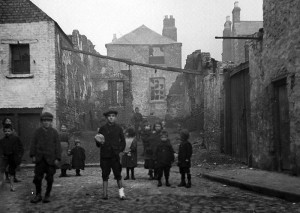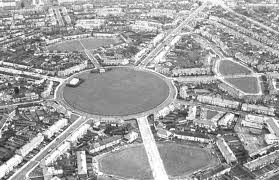Podcast: Public Housing in Twentieth Century Dublin with Ruth McManus

Cathal Brennan and John Dorney talk to Dr Ruth McManus about public housing in twentieth century Dublin.
Ruth McManus is the associate professor of geography at Dublin City University.
Dublin in the late nineteenth and early twentieth century was notorious for its slums – often deemed the worst in Europe and indeed, cited in some quarters as the worst in the world at that time outside of Calcutta. Disease including tuberculosis typhus and cholera was rife in 19th century Dublin.
Unlike, say Belfast, where relatively good quality low cost housing existed, built for that city’s burgeoning industrial working class, in Dublin many of the urban poor lived in single room tenements, either in decaying Georgian mansions, or, as Ruth notes, sometimes in insanitary cellars beneath them.
Radical nationalists and social reformers both cite the Dublin slums as one of the great blights on British rule in Ireland.
We talk about the 1913 housing inquiry that was promoted by a lethal collapse of one of the city’s tenements on Church Street, during the great strike or lockout of that year. The report of the inquiry recommended urgent action by the authorities to clear the slums, but it was not until well after Irish independence that progress was made. As Ruth mentions, one of the first such initiatives under the Irish Free State was the ‘garden city’ at Marino on Dublin’s northside in 1924.

It was part of the great narrative of Fianna Fail, the party that emerged under Eamon de Valera in 1926, that is, unlike its predecessor Cumman na nGaedheal, finally made serious progress towards slum clearance after its accession to power in the election of 1932.
Indeed as Barry Sheppard wrote on the Irish Story, the ‘anti-slum crusade‘ formed a major part of their rhetoric. However, Ruth argues here that the major housing projects, including the large new estates at Crumlin in Dublin were already planned before Fianna Fail’s election.
Nevertheless, the pattern of large sprawling suburban public housing estates did characterise much housing development in Dublin over the next fifty years ringing particularly the north and west of the Irish capital with large public housing estates. This brought with it its own problems – of alienation, social isolation, drug abuse and crime, but it did eventually clear the once infamous Dublin tenements, though not before another wave of anti-slum agitation in the 1960s and the last tenement was not demolished until the 1980s.

By the 1990s, Ireland had embarked on a new economic direction, driven largely by the dominant belief in the superiority of the free market. It was deemed that the state built social housing of the mid twentieth century had in some respects been a mistake – causing ‘ghettoisation’ and marginalisation.
The signal case most often cited was the high rise development at Ballymun on the city’s northside, which was built in the 1960s but eventually demolished and rebuilt as a mixture of public and private housing in the 2010s.
From then until today social housing was supposed to be incorporated into private housing developments, both to keep public spending down and also to promote more socially mixed neighbourhoods.
Whatever the success of this policy has been, in 2020, Dublin again suffers from an acute housing shortage. Ruth McManus argues here that it is time to revisit the notion that public housing was failure in twentieth century Dublin and that private enterprise cannot solve the public’s need for affordable housing.
This is just a taster of our conversation which you can listen to here.